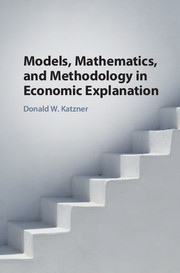Book contents
- Frontmatter
- Dedication
- Contents
- Preface
- Introduction
- 1 Science and Economics
- 2 Economic Models and Explanation
- 3 The Stages of Model Building in Economics
- 4 Models and Mathematics
- 5 Models and Measurement (or Lack Thereof)
- 6 Issues Relating to the Construction of Models from Scratch
- 7 An Example: The Efficiency of Organizational Forms
- 8 The Implicit Assumption Requirements of Later-Stage Model Building
- 9 Ordinality and the Adequacy of Analytic Specification
- 10 Categories of Models
- 11 Conclusion
- Index
9 - Ordinality and the Adequacy of Analytic Specification
Published online by Cambridge University Press: 26 October 2017
- Frontmatter
- Dedication
- Contents
- Preface
- Introduction
- 1 Science and Economics
- 2 Economic Models and Explanation
- 3 The Stages of Model Building in Economics
- 4 Models and Mathematics
- 5 Models and Measurement (or Lack Thereof)
- 6 Issues Relating to the Construction of Models from Scratch
- 7 An Example: The Efficiency of Organizational Forms
- 8 The Implicit Assumption Requirements of Later-Stage Model Building
- 9 Ordinality and the Adequacy of Analytic Specification
- 10 Categories of Models
- 11 Conclusion
- Index
Summary
From the vantage point taken here, analytical economics as exemplified in Chapter 7 holds as its objective and province of argument the explanation of economic behavior, decision, and choice. Analysis within its purview may or may not assume predictive competence as distinct from explanation; and it may or may not be readily adaptable to detailed empirical description and corroboration. The methods employed can, among other things, be directed to questions of agent optimization and welfare, or to those that bear on wider issues of aggregative activity or social benefit. In analyses of this sort, economists generally and typically construct models by postulating relational structures that have specific properties. Those contemplated relations, whichmay or may not be well specified andmay or may not be written in (ordinally, cardinally, or ratio) quantified functional form, are often reflective of deeper determinant forces. But in any case, it is well known that a number of difficulties stand in the way of such an approach.
First, it is obvious that for an analysis based on relational structures to have sustainable meaning, the structures and their properties must remain fixed throughout the investigation and over all relevant, analytically manipulative procedures. But second, questions of analytical legitimacy arise when, as suggested earlier, one or more of the variables incorporated in the argument are only ordinally measured while all remaining variables are taken to be at least cardinally quantified. In such a case, it is possible that the structures and properties assumed, if expressed only in the numerical terms of the quantified variables (ordinal, cardinal, and ratio), are dependent to a considerable extent on the scales on which the ordinal variables are measured. It follows that in the presence of such ordinality, the properties can often be altered or entirely lost upon application of certain increasing transformations of scale with respect to the ordinal variables.
- Type
- Chapter
- Information
- Models, Mathematics, and Methodology in Economic Explanation , pp. 192 - 211Publisher: Cambridge University PressPrint publication year: 2017



